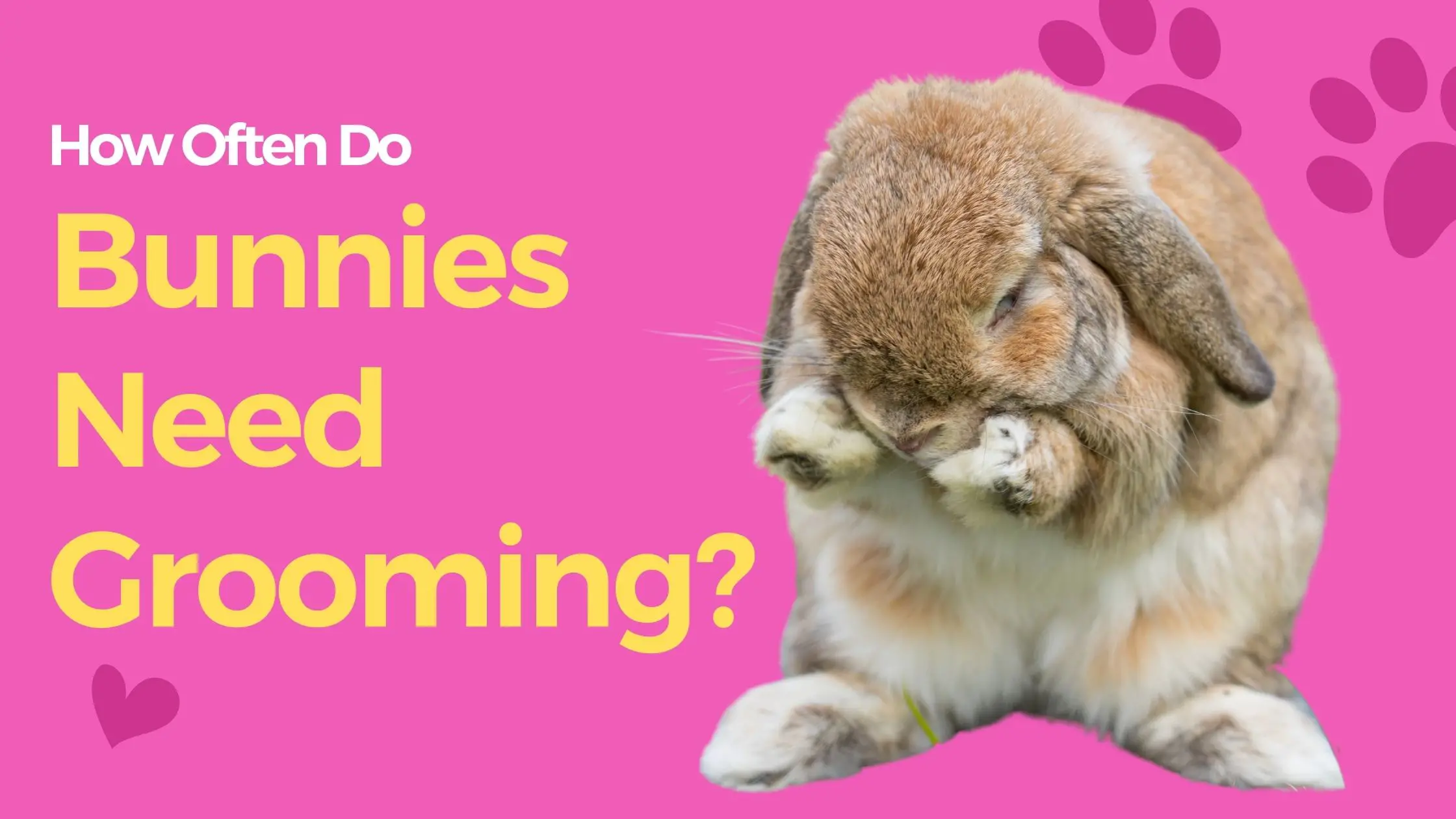Owning a rabbit comes with many responsibilities, including regular grooming. One question that rabbit owners often ask is, “How often do rabbits need grooming?”
In this article, we will explore the answer to that question and provide expert tips and guidance on pampering your furry friend.
Just like any other pet, bunnies require regular grooming to keep them healthy, comfortable, and looking their best – it’s part of rabbit care 101.
Stuck on how wondering how often do rabbits need grooming really?
Well, in this article, we will explore the importance of rabbit grooming, share some expert tips, and provide step-by-step guidance on how to groom your furry friend.
How Often Do Rabbits Need Grooming & Why Bother?
Proper grooming is vital in maintaining a rabbit’s overall health and well-being. It helps prevent issues like matting, hairballs, and skin infections. Regular grooming sessions also provide an opportunity to bond with your rabbit, fostering trust and strengthening your relationship.
If you’re not sure whether you have the time to invest into grooming your rabbit, you’ll need to weigh up the pros and cons of bunny ownership before diving in, especially as this is a BIG part of it.
Let’s delve into the reasons why grooming is essential for rabbits:
1. Preventing Matting
Rabbits have dense fur that requires regular attention. Without proper grooming, their fur can become tangled and matted. These mats can be uncomfortable for rabbits, causing them to feel itchy and irritated. If they’re really severe, it might also mean you have to shave your rabbit.
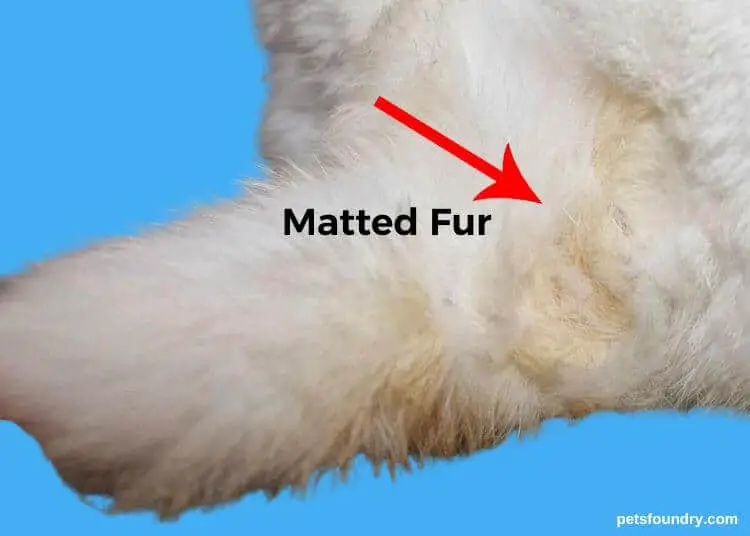
Additionally, mats can trap dirt, feces, and other debris, leading to skin infections. Regular brushing helps prevent matting, keeping their fur clean and tangle-free.
2. Hairball Prevention
Rabbits are meticulous groomers and ingest a considerable amount of fur when they’re making themselves look pretty. If they cannot pass this fur through their digestive system, it can accumulate and form hairballs.
From there, hairballs can cause gastrointestinal blockages, leading to serious health issues for rabbits. Rabbits need to be brushed to remove all loose tufts of fur, reducing the chances of hairball formation.
3. Maintaining Skin Health
Clean and well-kept fur contributes to healthy skin, especially when rabbit skin is delicate. Regular upkeep allows you to inspect your bunny’s skin for any signs of rabbit illness, irritation, wounds, or parasites.
You can promptly identify and address these issues to prevent them from developing into more significant problems. Grooming also stimulates blood flow to the surface, promoting a healthy coat and overall skin health.
4. Bonding and Social Interaction
Grooming provides an excellent opportunity to bond with your rabbit and strengthen your relationship, especially if you can hold the rabbit calmly and comfortably.
Spending quality time together during these sessions also helps build trust and enhances the human-rabbit connection. It allows you to handle your bunny gently and show them affection, making them feel secure and loved.
5. Early Detection of Health Issues
Pampering your bun plays a crucial role in maintaining their well-being, but have you ever asked yourself: ‘How often do rabbits need grooming if it relates to their health?
Looking over your cottontail friend regularly also means you can effectively monitor your bunny’s health and detect any potential issues early.
By observing their fur, skin, eyes, ears, and all rabbit nails, you can spot signs of illness or discomfort before they become a bigger problem. This enables you to seek veterinary care promptly, preventing further complications and ensuring your rabbit’s well-being.
6. Comfort and Hygiene
Rabbits are naturally clean animals, and grooming helps them maintain their hygiene. However, your house rabbit needs regular brushing to keep dirt, debris, and excess oils from their fur clean and fresh.
Even if they’re kept inside, it’s important that they’re brushed at least once a week, to ensure bigger issues don’t pop up.
Note that if you have a longer-haired rabbits, you may need to increase this frequency.
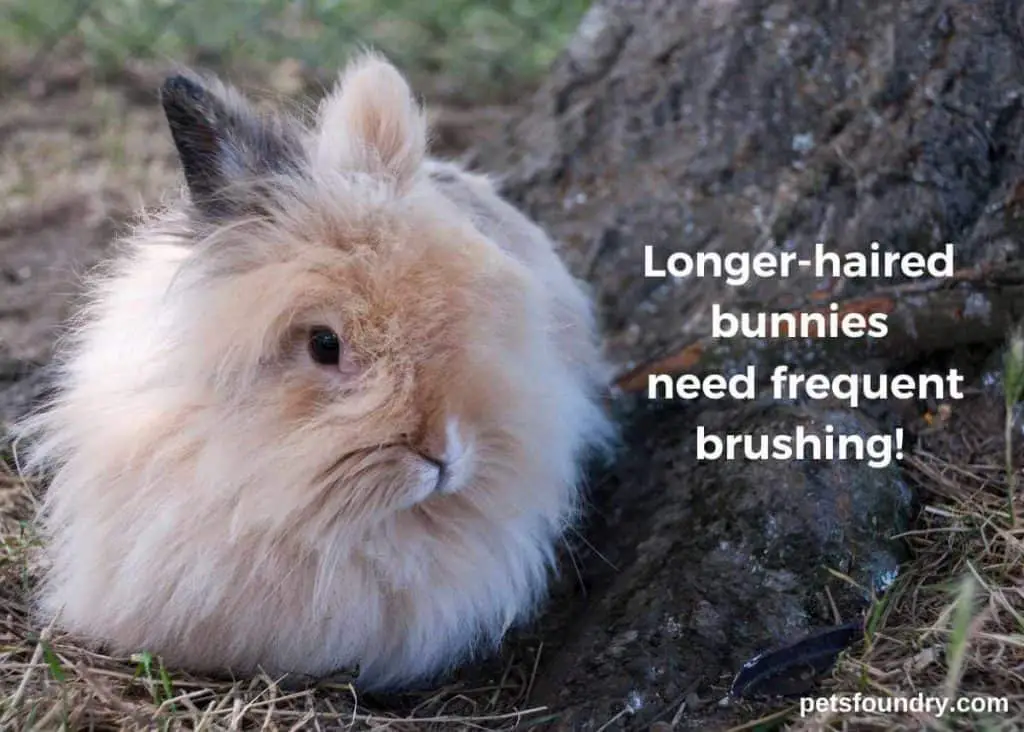
Additionally trimming their nails prevents overgrowth, which can cause discomfort and difficulty in movement, while cleaning their ears and teeth contributes to their overall comfort and prevents infections.
When you groom your rabbit, it’s all about is about keeping your bunny looking adorable and playing a crucial role in their health and happiness, preventing matting, hairballs, and skin infections while fostering bonding and social interaction.
It allows you to monitor their health, maintain their hygiene, and ensure their overall well-being. So, grab your grooming supplies and give your furry friend the pampering they deserve!
What You Need to Groom and Brush Your Rabbit
How often do rabbits need grooming if you brush them enough? Well, that also depends on how good your tools and supplies are, and how much you’re able to keep on top of this type of maintenance.
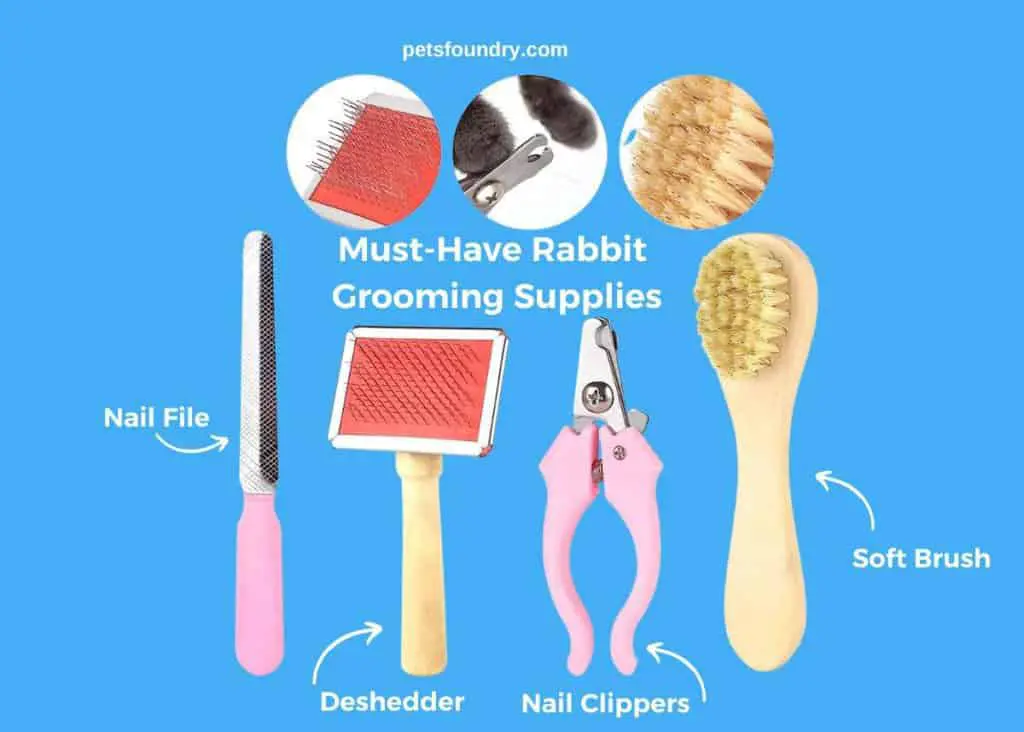
So, it’s time to get your bunny game on and treat your adorable rabbit to a spa day! But before you dive into the world of fluffy pampering, you’ll need to gather some essential supplies. Here’s a rundown of what you’ll need to make your rabbit’s grooming experience a breeze:
1. Use a Soft Type of Brush: Get that Fluff Under Control!
First things first, grab yourself a soft brush that’s specifically designed for these creatures – especially if your long-haired rabbits need something to get through all that fur.
These gentle brushes are perfect for removing loose fur and keeping your bunny’s coat in tip-top shape. Plus, they feel like a soothing massage for your furry friend. It’s a win-win!
Plus, if you keep on top of how much your rabbits shed, you shouldn’t need to clip your rabbit’s fur to free up any really bad knots and mats.
2. Nail Clippers: Clip Your Rabbit’s Nails with Care!
Invest in a pair of clippers specially designed for small animals. This way, you can safely trim their nails and avoid unnecessary discomfort. No bunny wants their nails to snag on things or get too long, so keep those clippers handy!
3. Cotton Balls: For Some Gentle Ear Cleaning!
A rabbit’s ears need some TLC too.
Grab a few soft cotton balls to keep those ears clean and free from wax buildup. These little fluffy wonders are perfect for giving your bunny’s ears a gentle wipe-down when needed. Remember, a clean bunny is a happy bunny!
4. Pet-Safe Ear Cleaner: Say Goodbye to Ear Troubles
While we’re on the topic of ears, make sure to have a pet-safe ear cleaner on hand. This will help you keep your rabbit’s ears spick and span. Choose a gentle and rabbit-friendly option to ensure you’re taking good care of those adorable lop ears.
5. Shallow Container: Splish, Splash, It’s Bath Time
Okay, let’s address the big B-word: bathing! While rabbits are generally clean animals and don’t need frequent baths, there are times when a bath may be necessary. (More on this down further.)
Grab a shallow container that’s big enough to accommodate your bunny comfortably. This will be your rabbit’s own personal spa oasis during bath time.
Note: We do not endorse bathing your bunny, as it can cause stress, damage and death in rabbits. A wet rabbit is often an unhappy one. We cover this in more detail below.
6. Rabbit-Specific Shampoo: Suds Up with Care
How often do rabbits need grooming if you bathe them? Well, truth be told, you shouldn’t be bathing them at all. Rabbits do not like water and can get extremely stressed if you place them in it. If your bunny does need extra attention when it comes to cleaning, we recommend going to a vet instead.
However, if you must bathe your rabbit, you’ll need a rabbit-specific shampoo that’s entirely natural.
Regular human shampoos can be too harsh for sensitive skin, so opt for one specially formulated for rabbits, or don’t even use one (that’s the better alternative). It’s all about keeping those bunnies fresh and clean without any unnecessary irritation.
Now that your rabbit grooming supplies are sorted, you’re ready to embark on this fluffy adventure! Remember, grooming is about maintaining your rabbit’s health and hygiene and spending quality time together and strengthening your bond.
So, grab those brushes, clippers, and cotton balls, and let the pampering begin!
We go into more detail on bathing your rabbit below.
The Secret Weapon: The Bunny Burrito
Mastering the art of a ‘bunny burrito’ is the ultimate way to keep your bunny safe and relaxed during your time grooming them. You can wrap your rabbit in the towel you should have handy, which will keep them calm enough for you to thoroughly attend to all their needs.
Here’s how to do a bunny burrito:
You’ll need a soft, lightweight towel or blanket and a calm, cooperative bunny.
Start by gently placing the towel or blanket on a flat surface, such as a table or your lap. Then, carefully lift your rabbit and place them in the center of the towel with their back against the fabric.
Next, fold one side of the towel over your rabbit’s body, making sure it’s snug but not too tight. Then, fold the other side of the towel over the first fold, creating a secure wrap around your bunny.
Finally, fold the ends of the towel underneath your rabbit’s body to keep them tucked in. The bunny burrito provides a sense of security and helps keep your rabbit calm during grooming or other necessary procedures.
Remember to handle your bunny with care and always monitor their comfort throughout the process.
Establishing a Bond with Your Rabbit: Fluff, Love, and Treats!
We all know that grooming sessions can sometimes make our fluffy friends a little jittery. But fear not! Building a strong bond with your rabbit is the secret ingredient to make those moments a breeze.
So, let’s dive into some tips on how to establish a paw-some connection with your furry companion:
How Often Do Bunnies Need Grooming? Enough to Spend Quality Time Together
The first step in creating a bond with your rabbit is to spend some good ol’ quality time together. Set aside dedicated time to hang out with your bunny buddy.
Whether cuddling on the couch, playing games, or exploring bunny-safe areas, ensure you’re giving them your undivided attention. They’ll appreciate your company and begin to associate you with positive experiences.
Offer Tasty Treats: Win Over Those Taste Buds
Now, who doesn’t love a delicious treat? Rabbits are no exception! Treats are a great way to win over your bunny’s heart when you need to brush your rabbit and they’re not having a bar of it.
Find out what treats they go hopping mad for and offer them as rewards during your bonding sessions. It could be a juicy piece of fruit or a special bunny treat from the pet store.
Yummy treats will make your rabbit look forward to spending time with you and create a positive association when it comes to trying to wrap your rabbit in a ‘bunny burrito’ to keep them calm.
Gentle Petting: Stroke That Fluff with Love
Rabbits are incredibly soft and cuddly creatures and absolutely adore gentle petting. Take some time to stroke their fur calmly and soothingly.
Pay attention to your rabbit’s body language and pet them where they enjoy it most. Some rabbits love chin rubs, while others prefer gentle strokes on their back. Discover what makes your bunny’s tail wag with joy!
Gradual Introductions: Respect Their Space
Remember, bunnies have their own personalities and preferences. Respect their space and take things at their pace.
If your rabbit is initially hesitant, give them time to adjust to your presence. Don’t force interactions or overwhelm them with sudden movements.
Slow and steady wins the race when it comes to building trust with your rabbit.
Trust-Building Grooming: Make It a Positive Experience
Now, let’s tie it all back to grooming.
Incorporate the trust-building techniques we’ve discussed to make grooming sessions a positive experience. Start by gently brushing your rabbit while offering treats and soothing words.
Gradually increase the length of the sessions as your rabbit becomes more comfortable. With time, your bunny will associate getting a brush with affection and care, making it a breeze for both of you.
Remember, building a bond with your rabbit takes patience and understanding. Every bunny is unique, so adapt your approach to suit their individual needs.
The more love, time, and treats you invest in your rabbit, the stronger your bond will become. So, go ahead and shower your furry friend with fluff, love, and lots of treats!
Brushing Your Rabbit’s Fur: Say Goodbye to Tangles and Hello to Fluffiness
Alright, rabbit enthusiasts, it’s time to tackle that fabulous fur! Regular brushing must keep your bunny’s coat in tip-top shape.
Grab your soft brush or a specially designed comb, and let’s work on maintaining that glorious fluff.
Here’s how to brush your rabbit’s fur like a pro:
Get the Right Tools: Soft Brush or Rabbit-Specific Comb
You’ll need the right tools to make brushing a pleasant experience for your bunny. Opt for a soft brush or a comb specifically designed for rabbits. These gentle grooming tools are perfect for removing loose fur and preventing tangles without causing any discomfort to your furry friend. Remember, we want our bunnies to enjoy the process.
Start with Gentle Strokes: Let the Fluffy Adventure Begin
Approach your rabbit with a calm and relaxed demeanor. Begin by gently stroking their fur in the direction of hair growth. This helps your rabbit feel at ease and gradually introduces them to the brushing sensation. Offer soothing words and gentle petting to make the experience enjoyable for both of you.
Focus on Problem Areas: Tangles, Begone
Certain areas of your rabbit’s fur are more prone to matting and tangling. Pay extra attention to these areas during your brushing sessions. The most common trouble spots include behind the ears and under the chin.
Remember to also brush in the direction the fur grows, so you don’t cause any unnecessary stress and discomfort for your furry friend.
Take time and gently comb through these areas, using slow and deliberate motions to remove tangles or mats. Be patient, and remember to offer treats and praise for cooperation.
Be Mindful of Your Rabbit’s Comfort: Keep It Fluffy, Not Rough!
While brushing, be mindful to check your rabbit and how comfortable it seems to be. They’re not like cats and dogs and can become stressed and in pain without you even realising it.
Avoid pulling or tugging on tufts of fur, as this can cause discomfort and potentially harm their delicate skin.
Take it slow and steady, and if you encounter a stubborn tangle, try gently working it apart with your fingers or a comb. Remember, we want a happy and fluffy bunny at the end of the grooming session.
Bonding Opportunity: Talk, Treats, and Love!
Brushing time is not just about maintaining your rabbit’s fur; it’s also an opportunity to strengthen your bond. Talk to your bunny in soothing tones, offer tasty treats as rewards, and give them plenty of affectionate strokes. This helps your rabbit associate grooming with positive experiences and deepens the connection between you and your fluffy companion.
By following these tips, you’ll become a master at brushing your rabbit’s fur. Regular brushing sessions will keep your bunny’s coat clean, healthy, and free from tangles.
5. Trimming Your Rabbit’s Nails
Let’s talk about nail care for our hoppy friends. Trimming your rabbit’s nails is a vital aspect of grooming that ensures their comfort and prevents potential health issues.
So, grab those small animal nail clippers and get ready to give your bunny’s nails some love. Here’s how to do it right:
The Right Tools: Small Animal Nail Clippers!
To give your rabbit’s nails a proper trim, you’ll need small animal nail clippers. These specialized clippers are designed with your bunny’s delicate nails in mind. Using the right tools ensures a safe and comfortable nail trimming experience for both you and your furry companion.
Handling with Care: Stay Calm and Bunny On!
Approach nail trimming with a calm and gentle demeanor. Find a quiet and well-lit area where you and your rabbit feel relaxed. It’s important to keep the atmosphere stress-free. Remember, rabbits can sense our emotions, so stay calm, and your bunny will follow suit.
The Tip of the Nail: Trim with Caution!
When trimming your rabbit’s nails, focus on the tip of each nail. Take extra caution not to cut too close to the quick—the sensitive part of the nail that contains blood vessels and nerves. Cutting into the quick can cause pain and bleeding. Trim just a small amount of the nail at a time, gradually working your way to the desired length.
Seek Professional Guidance: When in Doubt, Ask an Expert!
If you’re unsure about trimming your rabbit’s nails or need guidance, don’t hesitate to seek assistance from a veterinarian or a professional groomer.
They have the knowledge and experience to handle nail trimming with precision and care. They can also teach you the proper techniques, ensuring the well-being of your bunny’s nails.
Regular nail trims are essential for your rabbit’s comfort and overall health. Overgrown nails can lead to discomfort, difficulty in movement, and even health issues. By keeping their nails in check, you’re providing your bunny with a happy and pain-free life.
Get those small animal nail clippers ready, take a deep breath, and give your rabbit’s nails the attention they deserve. Your bunny will thank you with joyful hops and paws of appreciation!
Checking and Cleaning the Rabbit’s Ears: Keeping Those Ears Fresh and Fluffy
We know proper pampering for your bun is essential, but it’s important to know how frequently they need it when it comes to cleaning out their ears too.
So, let’s talk about those adorable lop ears and how to keep them clean and healthy. Rabbit ears are susceptible to wax buildup and infections, so regular care is essential.
Inspecting and cleaning your bunny’s ears will ensure their comfort and prevent potential ear issues. Here’s how to do it right:
Regular Inspections: Watchful Eyes on Those Ears!
Make it a habit to inspect your rabbit’s ears regularly. Look out for any signs of redness, swelling, discharge, or an unpleasant odor. These could indicate an ear problem, and early detection is key to maintaining your bunny’s ear health.
Gentle Cleaning: Soft and Safe Does the Trick
If you notice any dirt or wax buildup in your rabbit’s ears, it’s time for a gentle cleaning session.
First, gather some cotton balls and a pet-safe ear cleaner. Be sure to choose an ear cleaner specifically formulated for pets, as other products may be too harsh for your bunny’s sensitive ears.
Be Gentle: Handle with Care
When cleaning your rabbit’s ears, being gentle and cautious is important. Wet a cotton ball with the ear cleaner, but avoid saturating it. Carefully wipe the visible parts of the inner ear, focusing on the areas with dirt or wax buildup. Avoid inserting anything deep into the ear canal, which can cause harm and discomfort.
Seek Veterinary Care: When in Doubt, Ask a Pro
If you notice any concerning signs in your rabbit’s ears, such as persistent redness, swelling, discharge, or a strong odor, it’s best to seek veterinary care.
A veterinarian can assess the situation and provide appropriate treatment if necessary. They have the expertise to address underlying ear issues and ensure your bunny’s ears stay healthy and happy.
Regular ear inspections and gentle cleanings are essential for your rabbit’s ear health. You’ll prevent infections and discomfort by keeping their ears clean and buildup-free. It’s all about those fresh and fluffy ears!
So, put on your bunny detective hat, inspect those cute ears, and give them the gentle care they deserve. Your rabbit will appreciate the attention, and those lop ears will continue to be a source of endless adorableness!
7. Bathing Your Bunny: Keeping Your Rabbit Clean
Picture this: Your adorable bunny hopping around and suddenly finding themselves in a sticky or dirty situation. That’s when you know it’s time for a bunny bath!
While rabbits are generally clean animals and groom themselves, there are times when a bath becomes necessary. So, let’s dive into the world of rabbit bathing and ensure your furry friend stays fresh and fabulous.
When to Bathe: Sticky Mishaps and Dirty Bunnies!
Bathing a rabbit should be reserved for specific situations, such as when your bunny gets into something sticky, dirty, or potentially harmful.
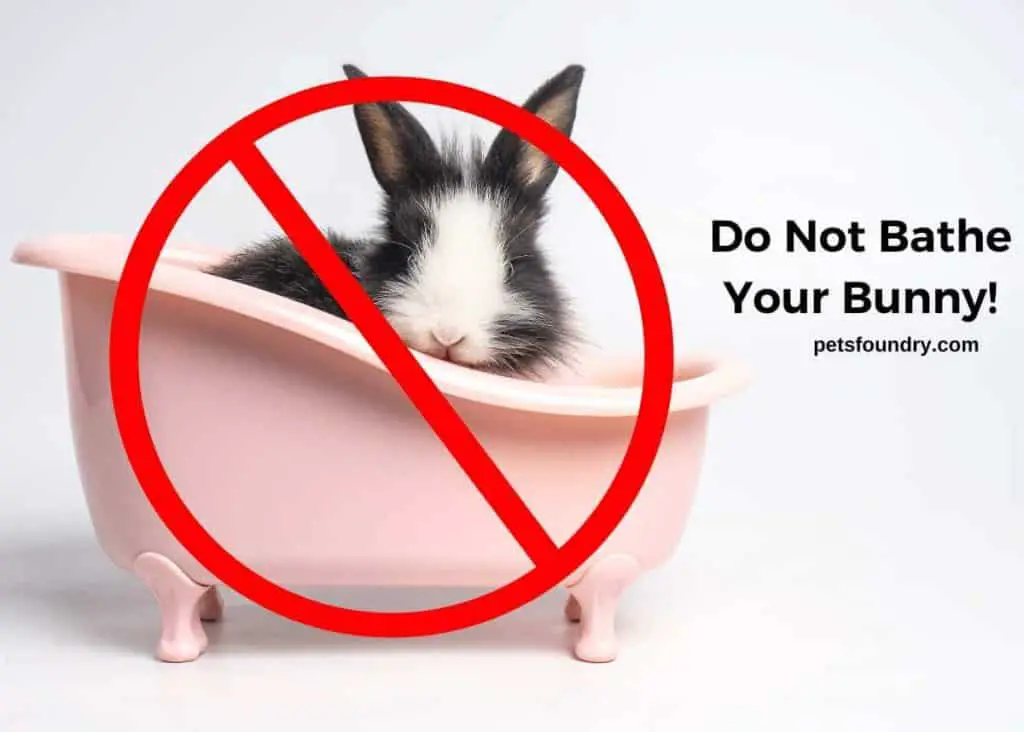
Most often, rabbits groom themselves efficiently and don’t require regular baths at all. But when life presents sticky situations, bathing is to keep your bunny clean and comfortable – however, it should only be done under expert guidance and care.
The Right Approach: Lukewarm Water and Bunny-Specific Shampoo
When bathing your rabbit, using the right approach and products is essential. Start by preparing lukewarm water, as excessively hot or cold water can cause stress to your bunny.
Fill a shallow container with enough water to allow your rabbit to stand comfortably but not deep enough for them to submerge.
Next, choose a mild rabbit-specific shampoo. These shampoos are specially formulated for the delicate skin of rabbits and won’t cause unnecessary irritation.
Avoid using regular human shampoo, as it can be too harsh for your bunny’s sensitive skin.
NOTE: You do not even need to use rabbit shampoo; in fact, you shouldn’t. We recommend you don’t bathe your bunny at all, unless there is a serious risk to their health. Bathing your rabbit can be fatal, if not done correctly, so if your bunny needs a wash, visit your vet.
Secure Bathing Area: Splash Time in a Bunny-Safe Zone
Creating a secure bathing area is crucial to ensure your rabbit’s safety during their bath.
Choose a space where your bunny can’t escape or injure themselves. You can use a bathtub or a large sink, but always ensure it’s clean, free from harmful substances, and offers good traction for your bunny’s paws.
Keep Those Ears Dry: Water-Free Bunny Ears
Rabbit ears are sensitive and should be kept dry during baths. Take extra care to keep water away from your rabbit’s ears.
You can use a damp cloth or sponge to gently clean the areas around the ears, but avoid getting water inside the ear canal. Keeping those bunny ears dry and happy is essential to their bath time experience.
Towel Time: Fluffing Up and Drying Off!
After the bath, it’s time to towel off your bunny. Use a soft towel to pat their fur dry gently.
Avoid vigorous rubbing, as this can cause unnecessary stress or discomfort. Ensure your bunny is kept warm during drying, especially if the weather is cool.
Once your rabbit is dry, offer plenty of praise, treats, and cuddles to make the experience positive.
Remember, bathing should be reserved for specific situations, and most of the time, rabbits can maintain their cleanliness on their own.
Following these tips will ensure a safe and pleasant bathing experience for your bunny, keeping them fresh and fabulous when sticky situations arise.
8. Dental Care for Rabbits: An Essential Guide to Bunny Teeth Health
Maintaining good dental hygiene is paramount to the overall health of our lovable lagomorph companions, the rabbits.
Unlike humans and some other pets, rabbit’s teeth grow continuously throughout their lives.
While advantageous in the wild, this unique characteristic can pose a serious health concern if not adequately addressed by a rabbit owner.
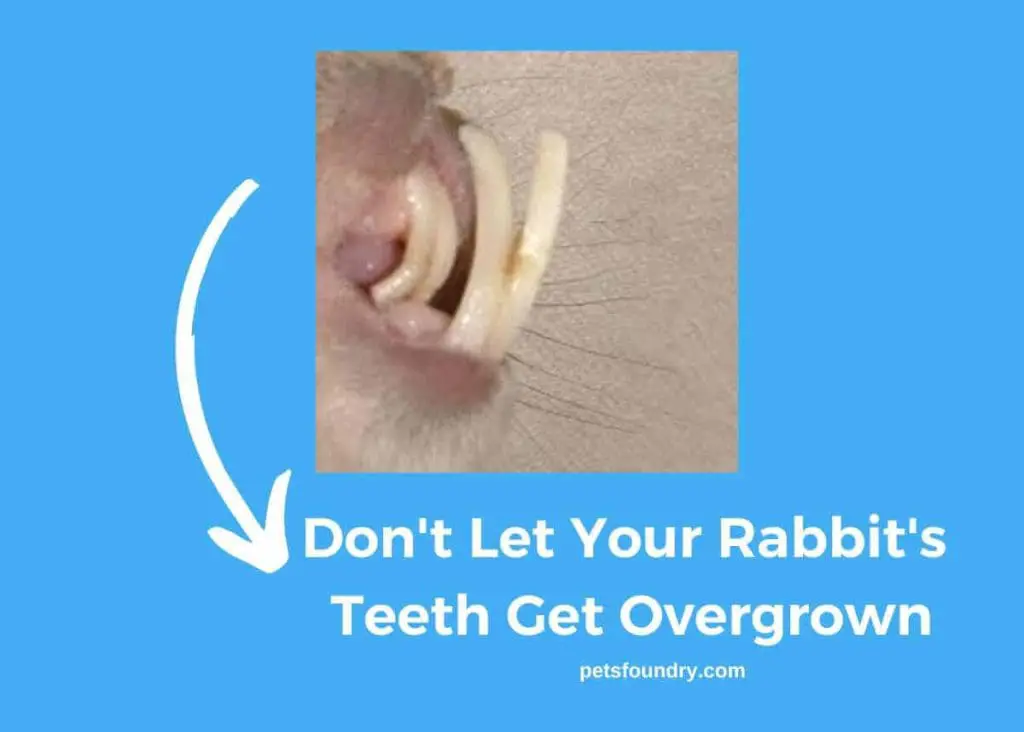
The Need for Dental Care in Rabbits
In the wild, a rabbit’s diet primarily comprises tough, fibrous material such as grasses and bark, which helps naturally wear down their teeth and prevent overgrowth.
However, in domestic situations, our pet rabbits often don’t get the same natural wear and tear, leading to dental issues.
Overgrown teeth can lead to painful conditions, difficulty eating, and even infections if the teeth grow into the mouth’s tissues. Therefore, the importance of providing your rabbit with proper dental care cannot be overstressed.
Providing the Right Diet for Dental Health
Providing a hay-rich diet is one of the best ways to promote natural tooth wear and maintain good dental hygiene in rabbits. Hay is the cornerstone of a healthy rabbit diet due to its high fiber content and rough texture, which helps to wear down teeth naturally.
It should comprise around 80-90% of a rabbit’s diet. Offering a variety of hay types, like timothy, orchard, or oat hay, can also keep your bunny interested in their food while maintaining their dental health.
Importance of Chew Toys
In addition to hay, providing a range of chew toys is another practical method for maintaining your rabbit’s dental health.
These toys help similarly to the hay, promoting natural teeth wear while providing mental stimulation for your rabbit. Toys made from safe woods, untreated willow, or even cardboard can all serve as effective and entertaining chew materials for your rabbit.
Regular Dental Checks
Aside from providing the right diet and chew toys, regularly checking your rabbit’s teeth for signs of overgrowth or other dental issues is crucial.
Overgrown teeth in rabbits are often signaled by changes in eating habits, weight loss, drooling, or discharge from the eyes or nose.
However, some dental problems may not exhibit visible signs in the early stages. Therefore, professional checks by a veterinarian are essential.
Most veterinarians recommend annual or semi-annual check-ups, but if you notice any symptoms, it’s best to consult your vet as soon as possible.
9. The Furry Truth: Handling Your Bunny’s Shedding Season
Ever looked at your rabbit and thought it was suddenly doubling in size? And then realized, nope, that’s not a magic trick, but your bunny buddy is in full-blown shedding mode?
If so, you’re not alone.
Rabbits, just like your favorite fuzzy sweater, go through their own version of shedding seasons. In fact, shedding is a natural process that occurs two to four times a year for bunnies, and each shedding period is referred to as ‘molting’.
That’s when they decide to change up their look and drop a lot of fur. Sometimes, it feels like a snowfall of bunny fluff in your living room!
Up Your Brush Game
During this time, your bunny will need a little extra help from their favorite human – that’s you!
Brushing becomes your best friend during shedding season. Not only does it keep your home from resembling a fur-filled winter wonderland, but it also keeps your rabbit’s coat in top shape. It helps to remove all the loose fur that can otherwise turn into mats.
Mats are like that tangle of headphones wires in your pocket; annoying and not something you want to deal with. So, keep up with the brushing.
Give ‘em the Good Stuff
Did you know that what your bunny eats also plays a big part in how their fur looks? A healthy diet means a healthy coat.
Ensure your rabbit is getting a balanced diet, packed with all the nutrients they need. You know the drill – lots of hay, fresh water, leafy greens, and a small handful of good-quality pellets. This is like the rabbit version of eating their fruits and veggies, and trust us, it pays off!
Exercise: Not Just for Humans
Last but not least, don’t forget about exercise. We’re not suggesting bunny boot camp or anything, but regular playtime and activity can also contribute to a healthier coat. Plus, it’s a great way to bond with your rabbit and tire them out for a peaceful evening.
Remember, shedding is just a part of the bunny life cycle, like bunny binkies and ear-flicking. So next time your rabbit starts to shed, don’t sweat it. Instead, grab that brush, dish up some quality bunny chow, and let the fluff fly!
11. Spotting the Red Flags: Recognizing Stress Signs During Grooming
Let’s talk about the flip side of the grooming coin: stress.
Yes, just like us humans, after a long week, our little furry buddies can get stressed, too, especially during grooming sessions. It’s super important for us to know the signs and know how to handle them.
Let’s dive in!
Thump Alert
Ever heard your rabbit thumping away like a drummer in a rock band? That’s a sign they’re not feeling too happy about what’s happening. If your rabbit starts thumping during grooming, it might be time to take a breather.
Freeze! Bunny Police!
If your rabbit freezes in place during a grooming session, they’re likely feeling anxious. This is their way of telling you, “Whoa there, human. Time to take it down a notch!”
Over-grooming and the Bite n’ Scratch Combo
Rabbits are clean animals, and they groom themselves regularly. But if your bunny starts over-grooming or biting and scratching more than usual during your grooming sessions, it’s a cry for help. They’re trying to tell you, “Hey, this is too much for me right now!”
So, what should you do if you spot any of these signs? First things first: stop. It’s like hitting the pause button on your favorite movie. Give your rabbit some space and time to chill out.
And remember, each bunny is unique, and they all have different comfort levels. It’s our job to figure out what works best for our furry friends and ensure they feel safe and loved during grooming.
Remember, it’s not a race! It’s okay to take breaks, offer a comforting cuddle, or distract them with their favorite treats. Understanding their stress signals and responding patiently and kindly is key to successful grooming sessions. Happy grooming!
12. The Pro Way: Choosing a Professional Rabbit Groomer
Hey, we get it! Sometimes, grooming your rabbit might feel like trying to solve a Rubik’s cube blindfolded. If you’re finding it tough or strapped for time, consider the pro way – hiring a professional bunny groomer. Let’s talk about why this could be a game-changer.
The Pros of the Pros: Who is Best To Groom a Rabbit?
Professional rabbit groomers are like the beauty salon masters for our bunny buddies. They’ve got the skills, the know-how, and the bunny-whisperer vibes to handle even the most grooming-averse rabbits.
Professional groomers have seen it all, from diva rabbits who refuse to sit still to the ones who think the grooming brush is their mortal enemy. They’ve got the patience of a saint and the gentle touch that your rabbit needs.
They Know Their Stuff
Professionals in this field aren’t just experts at making your bunny look cute. They also know a ton about bunny health and how to correctly hold your rabbit.
They can spot things like skin problems or signs of parasites that you might overlook. They’ll ensure your rabbit gets groomed without causing unnecessary stress or discomfort.
So, if you’re finding the grooming journey a tough trail to tread, don’t worry. There are pros out there who’ve got your back (and your rabbit’s!). It might cost a little more than doing it yourself, but the peace of mind and expert care can be worth every penny.
After all, it’s all about ensuring our furry friends feel their best, look their best, and live their best bunny lives!
13. The Angora Adventure: Grooming Your Fluffy Bunny
Angora rabbits are like the supermodels of the rabbit world. With their long, luxurious fur, they’re sure to turn heads! But keeping that beautiful coat in top shape? That’s a whole other ball game. So, let’s delve into the world of Angora grooming!
Brush, Brush, and Brush Some More
Angora rabbit’s long, thick fur isn’t just for show – it requires some serious upkeep. One of the most essential parts of Angora care is brushing. And not just a quick run-through with a brush; these bunnies need regular, thorough brushing to prevent their fur from matting.
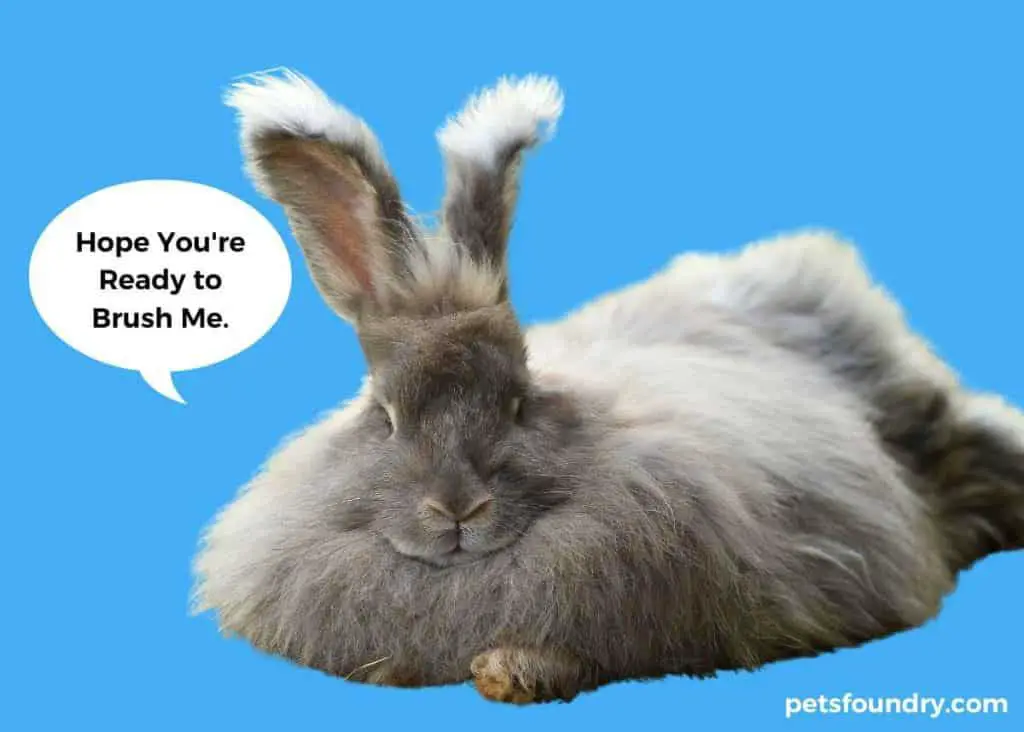
Matting is like that giant knot in your necklace chain – it’s annoying, tough to get out, and even painful for your rabbit. So, the more you brush, the less likely the fur forms those troublesome mats.
Choose Your Tools Wisely
All brushes are not created equal, especially regarding Angora grooming. Using a comb or brush specifically designed for these fluffy divas is recommended. These tools are gentle yet effective at removing loose fur without hurting your rabbit or damaging their coat.
So, when grooming your Angora rabbit, remember: it’s all about brushing. Regular, gentle grooming with the right tools will keep your bunny’s coat fluffy, mat-free, and fashionable. Plus, it’s a great opportunity for some bonding time with your supermodel bunny. Get ready to embrace the fluff!
Key Takeaways
- Regularly brush your rabbit’s fur to prevent matting.
- Trim your rabbit’s nails to avoid overgrowth.
- Check and clean your rabbit’s ears for wax buildup.
- Bathe your rabbit when necessary, using rabbit-specific shampoo.
- Ensure your rabbit has proper dental care.
- Help your rabbit through shedding seasons by frequent brushing.
- Handle grooming challenges with patience and positive reinforcement.
- Recognize signs of stress in your rabbit and adjust grooming accordingly.
- Consider professional rabbit groomers for expert care.
- Give special attention to grooming Angora rabbits.
Conclusion
Grooming is essential to rabbit care that promotes their health, comfort, and overall well-being.
By following the tips in this article, you can ensure your furry friend stays clean, stylish, and happy. Remember to approach grooming as a bonding opportunity and adapt the process to suit your rabbit’s individual needs.
FAQs
How often should I groom my rabbit?
The frequency of grooming largely depends on your rabbit’s breed and lifestyle.
However, generally speaking, rabbits with short coats should be groomed at least once a week, while long-haired breeds like Angora rabbits may require daily grooming due to their thick, long fur that is prone to matting.
Additionally, all rabbits will go through shedding seasons a few times a year, losing a lot of fur. During these periods, you’ll likely need to increase your grooming frequency to prevent ingesting too much hair and the subsequent risk of hairballs.
Remember, grooming isn’t just about keeping your bunny’s coat neat; it’s also an excellent opportunity to check for abnormalities like skin problems, lumps, or parasites.
Always be gentle and make grooming a positive experience for your bunny. If you’re uncertain or uncomfortable grooming your rabbit, consider seeking help from a professional groomer or a vet.
Can I use human shampoo on my rabbit?
No, using human shampoo or other human bath products on your rabbit is not recommended. Rabbits have very sensitive skin, and human products may disrupt their natural pH balance or cause irritation.
Rabbits are naturally clean animals that do not typically need baths or shampoo.
Baths can be very stressful and can even lead to dangerous situations like hypothermia if they’re not dried properly.
Instead, spot-cleaning soiled areas with a damp cloth and mild, rabbit-safe cleanser is usually sufficient for most rabbits.
If you believe your rabbit needs a bath due to a severe mess or medical condition, it’s best to consult a veterinarian or professional groomer first. They can guide the safest and most comfortable way to clean your rabbit or suggest a safe, rabbit-friendly shampoo if necessary.
What should I do if my rabbit hates being groomed?
If your rabbit dislikes being groomed, it can be challenging, but it’s not impossible to manage. Here are some tips:
Take it Slow: Begin with short grooming sessions and gradually increase the time as your rabbit becomes more comfortable. Start by touching and petting your rabbit before the actual grooming process.
Use Positive Reinforcement: Pair grooming with something your rabbit enjoys, like treats or cuddle time. Giving a small treat during or after grooming can help your rabbit associate the activity with positive experiences.
Stay Calm and Gentle: Your rabbit can sense your emotions. Your rabbit may feel the same way if you’re feeling frustrated or anxious. Stay calm and keep your movements gentle to help your rabbit stay relaxed.
Find the Right Tools: Some rabbits may not like certain grooming tools. Try different brushes or combs to see which ones your rabbit tolerates the best.
Consider Professional Help: If grooming at home continues to be a struggle, you may consider hiring a professional rabbit groomer. They have the experience and knowledge to groom your rabbit efficiently and with minimal stress.
Remember, it’s essential to maintain your rabbit’s grooming routine to prevent health issues, such as hairballs or skin infections. Your vet or a professional groomer can provide more personalised advice based on your rabbit’s specific needs.
Are there any specific tools I need for grooming an Angora rabbit?
Yes, due to their long and luxurious fur, Angora rabbits require a specific set of grooming tools to ensure their coat stays mat-free and healthy.
Here’s a list of essential grooming tools for your Angora rabbit:
Slicker Brush: These brushes are equipped with fine, short wires close together. They are excellent for removing loose fur and preventing matting in long-haired rabbits like Angoras.
Wide-Toothed Comb: This is great for gently working through tangles and mats in an Angora’s dense coat.
Fine-Toothed Comb: These can help remove smaller mats and tangles that the wide-toothed comb might miss.
Hair Blower: A hair blower (on a cool setting) can be useful for keeping your Angora’s fur fluffy and mat-free. Be sure to use this carefully and in a way that doesn’t frighten your rabbit.
Small Scissors: These are handy for carefully trimming mats that can’t be combed out. However, use these with extreme caution to avoid nicking your rabbit’s skin.
Can I groom my rabbit while it is molting?
Yes, in fact, it’s especially important to groom your rabbit during its molting (or shedding) phase. Rabbits can molt a few times a year and shed a significant amount of fur during these periods.
Regular brushing during molting helps to remove loose fur and prevent it from matting. More importantly, it prevents your rabbit from ingesting too much of its own hair when self-grooming.
Ingested hair can lead to serious digestive problems, including a potentially life-threatening condition called GI stasis.
However, be gentle while grooming a molting rabbit, as their skin may be sensitive during this time. If you notice bald patches, redness, or other signs of skin irritation while grooming, it’s best to consult a vet.
